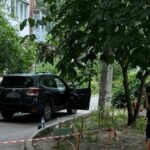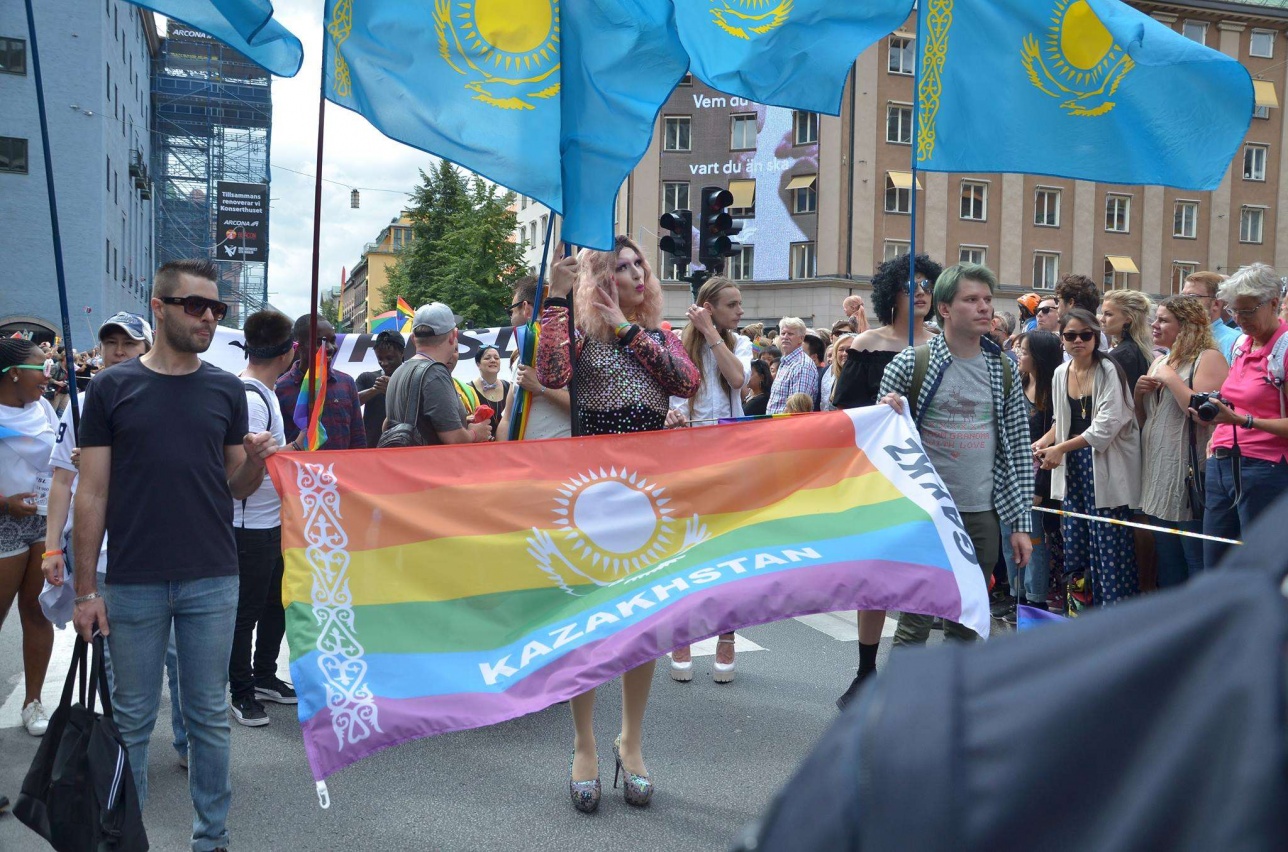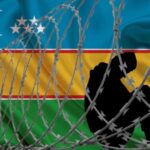The
Zhanaozen massacre was followed by the arrest, torture and jailing of activists
in 2012. The biggest strike in post-Soviet Kazakhstan’s history gave way to the
harshest wave of repression.
Almost
all of those jailed are now free. But trade unionists and human rights
campaigners continue to demand justice for those murdered and tortured, an
investigation of the inhuman and illegal state repression, and the reversal of
fraudulent trial verdicts.
The jail
sentences, of up to six years, were handed down in June 2012, at the end of a
trial of 37 oil workers and others on charges arising from the clash with the
police on 16 December 2011. The judge ignored lawyers’ protests that defendants
had been tortured in pre-trial detention.
Roza
Tuletaeva, a union activist who received one of the longest sentences, was last
year transferred from prison to an open penal colony, and last month (November
2014) released early, following an international protest campaign. Two workers
from Zhanaozen – Kanat Zhusipbaev and Shabdal Utkilov – are reportedly still
behind bars. Three more, from the nearby settlement of Shetpe, are presumed to
be in prison and are due for release this year or next.
The
multiple breaches by the state forces of human rights principles and of Kazakh
law are summarised in this article by ERLAN KALIEV, a human rights activist who
took part in the civil society commission formed to negotiate a settlement to
the strike in November 2011, was an observer at the oil workers’ trial, and has
campaigned on legal issues arising from the Zhanaozen events.
After
the tragedy of 16 December 2011 in Zhanaozen the general prosecutor’s office of
Kazakhstan made various declarations. For example, it was stated that “the
instigators of the disorder have been found”. Their trial would “dot all the
i’s and cross all the t’s”. The use of armed force by the police was accepted
as lawful, because participants in the disorders had had firearms. Having heard
this, all the observers and journalists followed closely every session of the
trial [of 37 Zhanaozen residents in June 2012, mostly on charges of
participating in mass disorder].
The
first doubts came when evidence was given by a shopkeeper, who refused to
accept a damages payment of almost 50 million tenge. This was the first
discovery we made at the “trial of the 37”. Everyone who was in Zhanaozen that
day [16 December 2011] saw the burned-out, looted buildings. But when the
shopkeepers, one after the other, refused damages, because they did not believe
that those on trial were guilty, more and more questions came into the heads of
those observing the trial.
Then we
bore witness, at one session after another, to the whole [prosecution] case
falling apart. There were a mountain of breaches of legal procedure – not just
of one particular regulation, but of a large number.
The use of torture
In
court, the accused started publicly to deny the testimony that they had given
during the investigation. They argued that they had been compelled to give that
testimony under the strongest psychological and physical pressure from police
officers. They spelled out concrete examples of how torture had been used
against them.
The most
common methods were suffocation with plastic bags; soaking with cold water at a
temperature of minus 20 or minus 30 degrees; and hanging by the hair from the
ceiling, as was the case with Roza Tuletaeva. The accused were made to stand
for many hours, to sleep on the bare, or even iced-over, floor. They threatened
to rape underage children, as became clear from the statements [in court] of
Tanatar Kaliev and Roza Tuletaev. [Aleksandr] Bozhenko spoke of how they beat
him mercilessly with switches [sheafs of branches] and jumped on him.
What’s
more, all the victims gave the names of those who had treated them so brutally.
They said that the perpetrators – police officers, prison staff or Committee of
National Security operatives – very often made no attempt to cover up their
identities. Their first names and surnames are in the court record. But there
has been no investigation.
These
statements [about torture in the police cells] were made against the background
of the authorities’ admission that the death of Bazarbai Kenzhebaev in the
Temporary Solitary Confinement Unit at Zhanaozen resulted from the brutal
beating and mistreatment that he suffered there. [Kenzhebaev, who had visited
Zhanaozen on 16 December 2011 to visit his daughter in the maternity hospital
there, was detained for two days by the security forces and held at the unit.
Shortly after being released he went to hospital with severe injuries and died.
In May 2012 Zhenisbek Temirov, the head of the Unit, was found guilty of
overseeing Kenzhebaev’s illegal detention, and of failing to send him to
hospital directly from the Unit. But no-one has been arrested or charged in
connection with the beating that apparently caused his death.] Kenzhebaev’s
case speaks volumes about the methods that prevailed at the Unit. And, by the
way, oil workers were detained at that same Unit – some during the preliminary
investigation [into the Zhanaozen events] and some after sentencing.
In
court, the observers were enraged by the authorities’ formal attitude – or, to
be precise, their contemptuous indifference – to the oil workers’ statements
about torture. [The defendants’] lawyers appealed formally to the court to
investigate these statements. Judge Aralbai Nagashibaev answered: I will
forward this appeal to the district prosecutor; they will be obliged to provide
an answer within ten days. Fifteen days went past, no answer was given, and the
judge said not a word. He was reminded about the issue. On the next day he
replied: there is an answer from the prosecutor, but the fact that people have
been tortured has not been confirmed.
Indeed,
the fact that torture had been used by police officers was not accepted in the
conclusions of an investigation – conclusions that, to the observers’
astonishment, were drawn not even by the prosecutors’ office, but for some
reason by the security service of the Interior Affairs Department [a law
enforcement agency]. In fact in these conclusions it was stated that the accused
[oil workers] had made claims about torture in order to escape justice.
Then the
[oil workers’] lawyers responded with concrete examples. In the case of Roza
Tuletaeva, for instance, they produced a clump of her hair by which she had
been hung from the ceiling. Her lawyer asked that criminal-juridical expertise
be sought to examine this clump of hair. But no-one lifted a finger to take
this clump of hair and make even a formal examination. (Nevertheless, Roza
Tuletaeva succeded in sending some of her hair via her daughter to Russia,
where expert witnesses confirmed that it had been violently pulled out.)
Those
who provided the conclusions regarding the issue of torture also forgot to
mention the case of Maksat Dosmagambetov, the only one of the accused oil
workers who managed by some miracle to make a complaint to the prosecutor when
he was in pre-trial detention – after which documentary evidence of the way
that he was beaten, including a broken rib, was drawn up in his detention cell.
He had been questioned by officers of the financial police.
Doubts about prosecution evidence
A second
moment of doubt concerned the evidence of the oil workers’ guilt that was given
by police officers. They claimed that they had arrested the 37 defendants
because witnesses had recognised them from xerox copies of photographs. This
caused astonishment among the observers. The 37 were not on the run. Many of
them presented themselves voluntarily at the first request by the police, and
were then detained at the Zhanaozen Temporary Solitary Confinement Unit. So
what then prevented the investigators from doing everything above-board and
arranging for the witnesses to identify the suspects visually? A vital
question.
The
third moment of doubt concerns the recorded statements of witnesses under
Article 100 of the Criminal Code [which provides for the use of anonymous
witness statements]. The inadmissibility of these statements was proven by the
testimony given in open court by witnesses who voluntarily revealed their
identities: Erlan Zhailykhanov (pseudonym Almaz Orazbaev) and Aleksandr
Bozhenko (pseudonym Kairat Allysbaev). Under oath they explained in detail to
the court the whole unlawful mechanism by which such witness statements were
put together by investigators.
In
Bozhenko’s case, he was arrested while walking along the street on 18 December
[2011] by the OMON [riot police]; was beaten, taken along Alan street, forced
to his knees and again beaten; taken to an interior mininstry garage where his
shoes were removed and he was forced to stand barefoot on the cold floor for
four hours; he was again beaten, and his hand was broken (an X-ray of this is
available); and then released. Then he was detained again, taken to the
prosecutors’ office, and told to identify Zhanat Murinbaev. At the prosecutors’
office Bozhenko saw a policeman, who he asked to help him; he refused. [As a
result of Bozhenko’s statement in court, Murinbaev was amnestied by the court.
In October 2012, four months after the end of the trial, Bozhenko was murdered
by unknown assailants. The police claimed he was the victim of a street brawl,
but human rights organisations believe that he was killed for speaking the
truth in court.]
Erlan
Zhailykanov said that he was arrested by the police on 27 December 2011;
threatened and beaten; and released at 3.0 am, shaking with cold and fear. He
asked the investigators where he could go, since a curfew was in place, but got
no response. On his way home Zhailykanov was again detained, by soldiers,
beaten by people in masks and released in the morning. A day later, he was
again arrested, at home, and compelled to sign two statements; “they told me
that if I did not sign and did not do what they needed, then I would be
jailed”, he said.
The use of armed force
In the
course of the trial it became clear that the general prosecutor’s assertions
about the use of armed force by the police being justified – on the grounds
that participants in the disturbances had firearms – were unfounded.
Volume
26 of the criminal case included statements by experts on the damage to the
[riot police] shields. According to these statements, the shields were damaged
by small pellets from hunting weapons, fired from a distance of not more than
15-25 metres. The police said that they were fired upon when they went out on
to Alan street, and for a second time after their morning parade. However on
numerous video films it can be seen clearly that when they emerged for the second
time they were in groups of 50-60 officers each, many in bullet-proof vests and
helmets, armed with heavy automatic weapons. How could participants in the
disturbances have got within 15-25 metres of these groups with hunting rifles
to shoot at them? If this really happened, then what prevented these groups of
police, who were armed to the teeth, from rendering such people harmless?
Another
fact that speaks volumes is that one of the prosecutors who worked on the
“trial of the 37”, and later gave evidence at the trial of five police officers
[who were charged with “exceeding their powers” during the Zhanaozen events]
had declared that the police had no reason to shoot at people, since the oil
workers had offered no active resistance to the law enforcement agencies.
Despite
all this, judge Aralbai Nagashibaev – without having heard convincing proof of
the guilt of the accused – nevertheless pronounced a guilty verdict in the
“trial of the 37”. This verdict went without substantial alteration through all
the appeal processes envisaged in the law, right up to the supervisory
collegium of the Supreme Court of Kazakhstan.
International law on torture
The
Republic of Kazakhstan, as a member of many international organisations, took
upon itself responsibilities, in terms of the defence of human rights and
freedoms, that at present it does not fulfil. In particular, on 24 January 2006
Kazakhstan ratified the International Covenant on Civil and Political Rights
and the Optional Protocol to it. Given the character of the offences brought to
light in the course of the Zhanaozen trials, it is clear that Kazakhstan did
not abide by provisions of the Covenant, including: Article 6 on the right to
life; Article 7 on the freedom not to be subjected to torture or to cruel,
inhuman or degrading treatment; Article 9 on the freedom from arbitrary arrest
or detention; Article 10 requiring that persons deprived of their liberty be
treated with humanity and respect; and Article 14 on the right to a just court
procedure.
Kazakhstan
also joined the United Nations Convention against Torture on 26 March 1998, and
ratified the Optional Protocol to it on 22 October 2008, thereby putting itself
under the jurisdiction of the UN Committee Against Torture and the Subcommittee
on Prevention of Torture. Under Article 22 of the Convention Against Torture,
individuals subject to the jurisdiction of a state that is party to the
Convention have the right to make individual complaints to the Committee that
torture, or other cruel, inhuman or degrading treatment, has been used against
them by that state. Moreover, a state that has signed and ratified the Optional
Protocol is obliged to established a mechanism at national level to prevent
torture and other cruel, inhuman or degrading treatment.
The
repeated statements about physical and psychological violence used in the
course of the investigation in to the events at Zhanaozen on 16-17 December
2011, and the course and result of the court cases, put a huge question mark
over the objectivity and just character of the Kazakh judicial system, and over
the government’s claims to be observing international standards and
responsibilities.
Kazakhstan and Europe
Considering
that:
■ The
legal processes at Zhanaozen could not be considered to have adhered to the
normal standards of justice, according to the conclusions of a preliminary
report of an international monitoring mission to Kazakhstan by the Civic
Solidarity Platform [an umbrella group of NGOs, mostly in the former Soviet
Union and eastern Europe, focused on human rights issues]; and that the mission
also found the investigation that followed the events of 16 December 2011
incomplete and slanted;
■ The
human rights of the accused, and some witnesses, were breached during the
pre-trial investigation, including by the use of torture, deprivation of access
to a lawyer, intimidation and the falsification of evidence;
■ The
evidence of the use of torture and brutal treatment during pre-trial detention,
given by the accused in the course of the trials, was not objectively and
carefully investigated in full, and that responsibility was placed on the
accused themselves;
■ On 7
October 2012 Aleksandr Bozhenko, one of the witnesses of the tragic events at
Zhanaozen, was killed; and that
■ The UN
High Commissioner for Human Rights, Navi Pillay, after a two-day visit to
Kazakhstan in July 2012 called on the authorities to allow and facilitate an
independent international investigation into the causes and consequences of the
events in Zhanaozen, has “not been heard” by the Kazakh authorities since then,
and not during their negotiations of a bilateral agreement with the European
Union …
The only
possibility left to democratic society in Kazakhstan is to appeal to the heads
of European countries, who are about to sign this agreement with Kazakhstan, to
ask them for the necessary cooperation in carrying out an international
investigation of the tragedy at Zhanaozen that can be taken account of in
future judicial proceedings.
[Note.
In October 2014, after this article was written, Kazakhstan signed its Enhanced
Partnership and Cooperation Agreement with the European Union. (Details here.)
The points made about putting pressure on EU governments of course remain
valid.]
Translation
by Gabriel Levy, December 2014.
SOURCE:
http://peopleandnature.wordpress.com/2014/12/10/kazakh-oil-workers-the-fight-for-justice-goes-on/

















